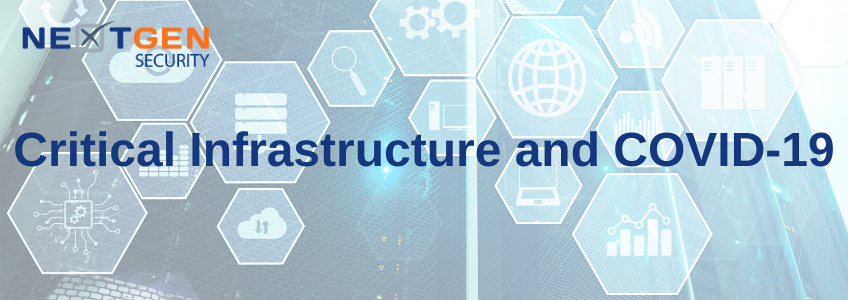Working in the security and life safety sector is something each of us in this vital industry take much pride in. The work we do is important, and is evidenced by the U.S. Department of Homeland Security (DHS) identifying integrators as “essential critical infrastructure workers during the COVID-19 response.”
To help navigate these uncertain waters, the Department of Homeland Security Cybersecurity and Infrastructure Security Agency (CISA) has released information pertaining to critical infrastructure and COVID-19. In their recent Memorandum on Identification of Essential Critical Infrastructure Workers During COVID-19 Response, the publication states: “If you work in a critical infrastructure industry, as defined by the Department of Homeland Security . . ., you have a special responsibility to maintain your normal work schedule.”
CISA leverages trusted partnerships with both the public and private sectors to deliver infrastructure resilience assistance and guidance and, in collaboration with other federal agencies, developed the initial list of “Essential Critical Infrastructure Workers” to help state and local officials as they work to protect their communities, while ensuring continuity of functions critical to public health and safety, as well as economic and national security.
As we have been from the onset of this terrible pandemic, we at NextGen remain committed to providing important information that impacts all of us working in this sector and the customers we serve and protect. CISA’s Guidance on Essential Critical Workers Memorandum contains a lot of important information. Here we provide for you some of its key takeaways.
“Functioning critical infrastructure is imperative during the response to the COVID-19 emergency for both public health and safety as well as community well-being. Certain critical infrastructure industries have a special responsibility in these times to continue operations.”
“This guidance and accompanying list are intended to support State, Local, and industry partners in identifying the critical infrastructure sectors and the essential workers needed to maintain the services and functions Americans depend on daily and that need to be able to operate resiliently during the COVID-19 pandemic response. This document gives guidance to State, local, tribal, and territorial jurisdictions and the private sector on defining essential critical infrastructure workers. Promoting the ability of such workers to continue to work during periods of community restriction, access management, social distancing, or closure orders/directives is crucial to community resilience and continuity of essential functions.”
As stated above, the U.S. Department of Homeland Security (DHS) has named integrators as “essential critical infrastructure workers during the COVID-19 response” and their guidelines can encompass residential work, as well. And while we all remain committed to providing security services to our valued customers, we at NextGen implore all of us, as essential workers, to do all we can to stay healthy and safe. For themselves, their families, their clients, and their communities. By doing so, we’re also helping lighten the already very heavy load put upon our healthcare workers, first responders and our other fellow essential workers. Here are some published tips on how essential workers can help protect themselves and others during this pandemic.
“People in critical infrastructure roles who have been exposed to COVID-19 but don’t have any symptoms should check their temperatures before going to work, monitor for any symptoms, wear a face mask for at least two weeks after being exposed, practice social distancing and maintain 6 feet of space between others, and disinfect and clean work spaces, according to the CDC. Exposure is defined by the CDC as “being a household contact or having close contact within 6 feet of an individual with confirmed or suspected COVID-19.”
According to the CDC, “Employers should take workers’ temperatures and monitor symptoms, send anyone home who gets sick, increase airflow in buildings, test to see if wearing masks interferes with work, and cleaning high-touch surfaces more frequently. Additionally, workers should be allowed to take staggered breaks to reduce their contact with others, avoid congregating in break rooms, and avoid sharing any utensils or food.”
AtWork has also posted some important tips on how essential workers can stay safe during this pandemic. AtWork is part of The Workforce Alliance which is a collective of innovative companies that are changing the way companies see workforce management by providing everything from advisory services to complete program management. The Workforce Alliance brings together industry experts to create unparalleled strategic programs. Here’s the advice they offer to essential workers:
Put your phone away at work – You likely bring at least one or two things to work that you take back home with you each day, such as your phone, keys, wallet, etc. Make sure you put all of these away when you get to work so that you’re not interacting with them throughout the day and so that they aren’t near other people who could potentially contaminate them.
Clean up before leaving work – Make sure you wash your hands before you leave work for the day. Ideally, clean them up to your elbows. Hand washing is one of the best ways to protect yourself and your family from getting sick.
Clean up before walking into your home and immediately after entering – Take off items like shoes before entering and leave them outside. Once you walk inside, take off your clothes so that they can be washed. Make sure you clean personal items you took to work, especially your phone. Then immediately go shower.
We at NextGen take our responsibility as essential workers very seriously. We stand ready to help all of our customers meet their security needs during these challenging times. We are closely following the safety guidelines set forth to ensure we are helping in the fight to put an end to this invisible enemy. We are prepared to serve on the frontlines of this pandemic and continue to deliver best in class security solutions, many of which are needed more now than ever.
To read CISA’s Guidance on Essential Critical Workers Memorandum in its entirety, please go to: https://www.cisa.gov/sites/default/files/publications/CISA-Guidance-on-Essential-Critical-Infrastructure-Workers-1-20-508c.pdf

